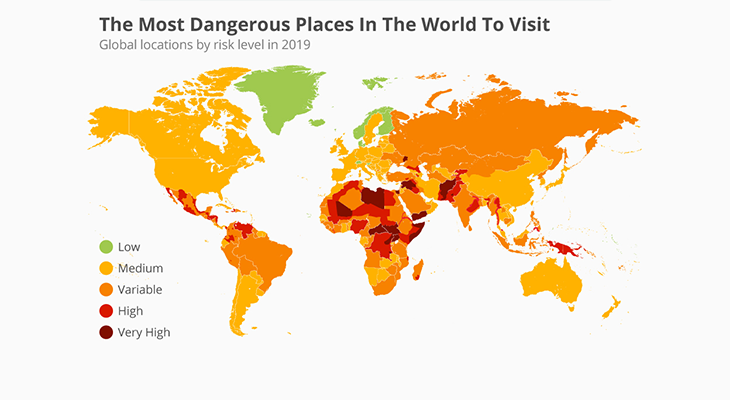Most Unsafe Places to Travel in 2025: Data‑Driven Risk Guide

Travel risk changed markedly going into mid‑2025: geopolitical conflicts, organized crime, infrastructure fragility, climate‑intensified disasters, and cyber‑enabled scams have shifted which destinations appear on “most unsafe” lists yet risk is layered (political violence, crime, health, disaster exposure) and varies neighborhood‑to‑neighborhood. This most unsafe places to travel guide synthesizes current government advisories (e.g., Level 4 “Do Not Travel”), peace and conflict indices, homicide data, disaster risk rankings, and emerging perception issues so you can distinguish headline fear from actionable risk management, avoid sensationalism, and travel ethically when visits are essential (family, journalism, humanitarian work).
Table of Contents
- How This List Was Built
- Key Dimensions of “Unsafe”
- Top Advisory (Level 4) & Conflict Zones
- Least Peaceful Rankings
- High Homicide / Criminal Violence Environments
- Disaster & Climate Vulnerability Layer
- Emerging Tourist Perception Shifts
- Organized Crime Spillover into Tourism Areas
- Kidnapping & Abduction Hotspots
- Gender‑Based & Sexual Violence Concerns
- Urban “Worst City” Narratives vs Nuance
- Media Sensationalism vs Structured Data
- Ethical & Responsible Travel in High‑Risk Areas
- Risk Mitigation Framework
- Comparative Risk Snapshot
- Quick Takeaways
- Conclusion
- FAQs
How This List Was Built
We triangulate multiple quantitative sources instead of a single sensational index: (1) U.S. State Department Level 4 & Level 3 advisories (political violence, kidnapping, terrorism) plus recent updates; (2) Global Peace Index least‑peaceful rankings (macro conflict & societal safety scores); (3) UNODC & homicide rate datasets (criminal violence intensity); (4) World Risk Report disaster vulnerability and exposure; (5) qualitative incident trends (cartel spillover into tourism zones) and emerging perception issues impacting traveler decisions.
Key Dimensions of “Unsafe”
“Unsafe” is multidimensional: armed conflict/terrorism risk, violent & organized crime (homicide, kidnapping, extortion), petty crime, disaster likelihood (earthquakes, cyclones), structural fragility (healthcare, governance), and situational hazards (corruption, infrastructure failure). High homicide does not always mean high terrorism risk; severe disaster exposure can exist in otherwise peaceful societies.
Top Advisory (Level 4) & Conflict Zones
Countries consistently on Level 4 “Do Not Travel” lists in July 2025 include Afghanistan, Haiti, parts of Myanmar (Burma), Sudan/South Sudan, Yemen, Iran (for certain nationalities), Central African Republic, Burkina Faso, Democratic Republic of the Congo and others reflecting elevated risks of armed conflict, state fragility, kidnapping, or terrorism.
Least Peaceful Rankings
The Global Peace Index again places Afghanistan, Yemen, Syria, Russia, South Sudan, Sudan, and others at the bottom, signaling persistent conflict intensity, displacement, and militarization drivers of traveler vulnerability (sudden escalations, restricted consular help, infrastructure disruption).
High Homicide / Criminal Violence Environments
Intentional homicide data highlight countries (not always under full conflict) where criminal violence (cartels, gangs) elevates risk these include regions in Latin America with rates vastly above global averages, impacting both direct victimization probability and indirect risks (stray violence, extortion pressure on transport providers).
Disaster & Climate Vulnerability Layer
World Risk / disaster assessments rank countries like the Philippines, Indonesia, India, Colombia and others high for combined hazard exposure + vulnerability, meaning even routine trips can be disrupted by typhoons, earthquakes, floods or landslides compounding other risk layers when governance capacity is stretched.
Emerging Tourist Perception Shifts
Destination safety perception can shift fast: declines in visitor numbers trace to safety concerns (scams, trafficking narratives, discriminatory incidents), altering crowd dynamics and possibly reducing resources directed to tourist policing in the short term until recovery strategy reforms occur.
Organized Crime Spillover into Tourism Areas
Cartel conflict in certain regions continues to affect destinations previously insulated (e.g., resort corridors), raising the salience of “bystander risk” and necessitating micro‑level risk mapping (time of day, transit routes, nightlife districts) beyond national advisory generalities.
Kidnapping & Abduction Hotspots
Heightened kidnapping warnings in some African and Middle Eastern contexts (Libya, parts of the Sahel) have led to unusually explicit governmental messaging urging contingency planning (wills, dependent care, crisis funds), illustrating severity of operational and legal system hurdles in hostage resolution.
Gender‑Based & Sexual Violence Concerns
Advisories flag increased caution in certain countries due to sexual assault incidents in tourist zones, particularly where legal processes are slow or social stigma hampers reporting women (and LGBTQ+ travelers) must calibrate nighttime mobility, transport choices, and lodging vetting accordingly.
Urban “Worst City” Narratives vs Nuance
Lists naming “worst” cities often overgeneralize; risk inside mega‑cities varies drastically between central business districts, informal peripheries, and controlled tourist corridors underscoring the need to disaggregate “city‑wide danger” from targeted micro‑environments.
Media Sensationalism vs Structured Data
Tabloids may amplify alarming advisory language (e.g., urging wills), but savvy travelers should prioritize primary advisory portals plus neutral conflict & crime datasets, triangulating instead of adopting uncontextualized fear headlines.
Ethical & Responsible Travel in High‑Risk Areas
Where travel is essential (journalism, humanitarian relief, family obligations), risk mitigation should include hostile environment training, communications redundancy (satellite messengers where lawful), evacuation insurance riders, and context‑sensitive behavior to avoid burdening local security resources.
Risk Mitigation Framework
Structured methodology: (1) Macro filter (advisory & peace index); (2) Threat taxonomy (conflict, crime, health, disaster); (3) Itinerary segmentation (transit nodes vs rural vs urban core); (4) Controls (route variation, secure transport, travel tracking, low‑profile behavior); (5) Contingency (medical evacuation, extraction triggers).
Comparative Risk Snapshots
| Dimension | Example High‑Risk Countries (2025) | Primary Drivers | Advisory / Index Signals |
|---|---|---|---|
| Armed Conflict | Afghanistan, Yemen, Sudan, South Sudan, Syria | Active conflict, terrorism | GPI bottom ranks; Level 4 |
| Criminal Violence | Parts of Mexico, Haiti, DRC | Cartels, gangs, weak policing | Level 3–4 + high homicide |
| Kidnapping | Libya, Sahel corridor (Burkina Faso), parts of Nigeria | Militant & criminal groups | Explicit advisory cautions |
| Disaster Exposure | Philippines, Indonesia, India, Colombia | Cyclones, quakes, floods | World Risk high rankings |
| Perception Shift | Selected SE Asia destinations | Scams, trafficking narratives | Visitor decline & safety perception |
Quick Takeaways
- “Unsafe” is multi‑layered: conflict, organized crime, disasters, structural fragility seldom overlap perfectly.
- Level 4 advisory countries cluster with bottom Global Peace Index rankings, but homicide or disaster risk can elevate danger elsewhere.
- Perception shocks (scams, trafficking stories) can suppress tourism and reshape security dynamics.
- Cartel spillover & kidnapping hotspots demand itinerary micro‑planning, not blanket avoidance alone.
- Disaster vulnerability compounds other risks when infrastructure and governance are strained.
- Ethical travel in high‑risk areas prioritizes necessity, preparation, and minimal local burden.
Conclusion
Lists of the most unsafe places to travel can mislead when they compress diverse hazards into a single label; in 2025 nuanced risk intelligence matters more than ever. Conflict zones (Afghanistan, Yemen, Sudan) share space on warning lists with criminal violence areas (certain Mexican states, Haiti) and with disaster‑prone but otherwise stable countries where hazard exposure is the dominant threat. Media sensationalism (dramatic kidnap warnings or perception declines) can distract from systematic preparation cross‑referencing advisories, peace indices, homicide statistics, and disaster risk models to build layered mitigation. Responsible travelers differentiate non‑essential leisure trips (postpone or reroute) from essential journeys (equip with training, secure logistics, contingency triggers). Adopt the “risk funnel” approach: filter macros, classify threat types, segment itinerary zones, apply control measures, finalize evacuation thresholds. By reframing “unsafe” as a matrix rather than a label, you replace fear with informed strategy protecting yourself while respecting complex local realities.
Frequently Asked Questions
1. What qualifies a destination for “most unsafe places to travel” lists?
A convergence of Level 4 advisories, low peace index ranking, high homicide or kidnapping incidence, and/or acute disaster vulnerability typically triggers inclusion.
2. Are high homicide countries always conflict zones?
No some nations exhibit extreme homicide rates due to organized crime without nationwide war, requiring targeted urban risk controls instead of front‑line conflict protocols.
3. How do disaster risks alter safety planning?
High disaster exposure demands early warning app setup, flexible bookings, and evacuation insurance even where political and crime risks are moderate.
4. Why did some popular destinations see perception declines?
Incidents (scams, trafficking cases, discrimination narratives) amplify safety concerns, reducing arrivals and shifting resource allocation for tourist policing.
5. How should essential travelers mitigate kidnapping risk?
Use vetted drivers, vary routes, keep a low profile, enable travel tracking, and pre‑arrange crisis management & evacuation support in explicit kidnapping advisory zones.


